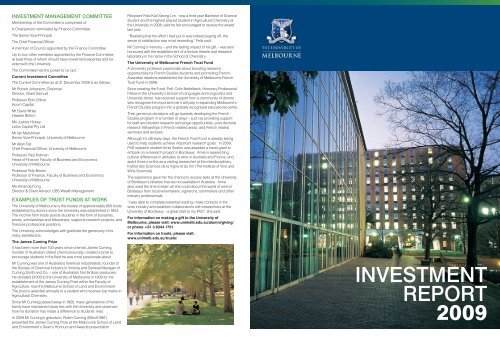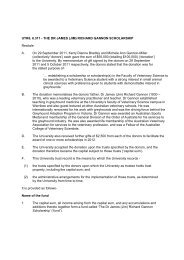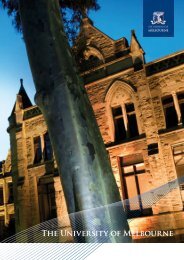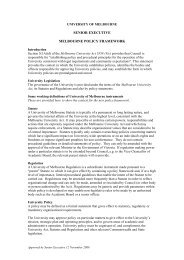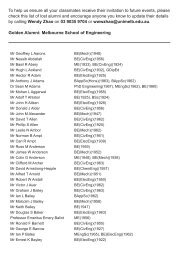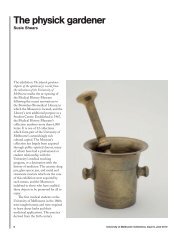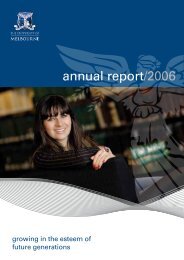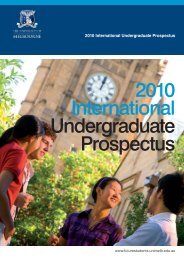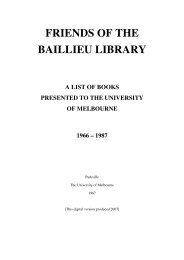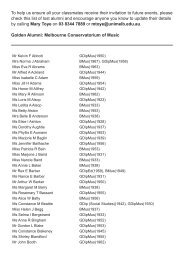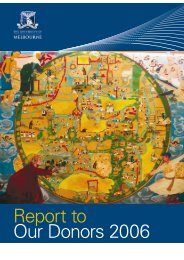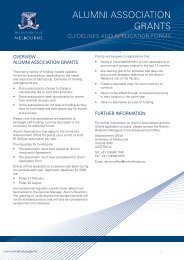2009 Investment report - University of Melbourne
2009 Investment report - University of Melbourne
2009 Investment report - University of Melbourne
Create successful ePaper yourself
Turn your PDF publications into a flip-book with our unique Google optimized e-Paper software.
INVESTMENT MANAGEMENT COMMITTEE<br />
Membership <strong>of</strong> the Committee is comprised <strong>of</strong>:<br />
A Chairperson nominated by Finance Committee<br />
The Senior Vice-Principal<br />
The Chief Financial Officer<br />
A member <strong>of</strong> Council appointed by the Finance Committee<br />
Up to four other members appointed by the Finance Committee,<br />
at least three <strong>of</strong> whom should have investment expertise and be<br />
external to the <strong>University</strong>.<br />
The Committee has the power to co-opt.<br />
Current <strong>Investment</strong> Committee<br />
The Current Committee as at 31 December <strong>2009</strong> is as follows:<br />
Mr Robert Johanson, Chairman<br />
Director, Grant Samuel<br />
Pr<strong>of</strong>essor Bob Officer<br />
Acorn Capital<br />
Mr David White<br />
Hawker Britton<br />
Ms Justine Hickey<br />
Lotus Capital Pty Ltd<br />
Mr Ian Marshman<br />
Senior Vice-Principal, <strong>University</strong> <strong>of</strong> <strong>Melbourne</strong><br />
Mr Allan Tait<br />
Chief Financial Officer, <strong>University</strong> <strong>of</strong> <strong>Melbourne</strong><br />
Pr<strong>of</strong>essor Paul K<strong>of</strong>man<br />
Head <strong>of</strong> Finance, Faculty <strong>of</strong> Business and Economics<br />
<strong>University</strong> <strong>of</strong> <strong>Melbourne</strong><br />
Pr<strong>of</strong>essor Rob Brown<br />
Pr<strong>of</strong>essor <strong>of</strong> Finance, Faculty <strong>of</strong> Business and Economics<br />
<strong>University</strong> <strong>of</strong> <strong>Melbourne</strong><br />
Ms Amanda Fong<br />
Director & Client Advisor, UBS Wealth Management<br />
EXAMPLES OF TRUST FUNDS AT WORK<br />
The <strong>University</strong> <strong>of</strong> <strong>Melbourne</strong> is the trustee <strong>of</strong> approximately 800 trusts<br />
established by donors since the <strong>University</strong> was established in 1853.<br />
The income from trusts assists students in the form <strong>of</strong> bursaries,<br />
prizes, scholarships and fellowships; supports research projects; and<br />
finances pr<strong>of</strong>essorial positions.<br />
The <strong>University</strong> acknowledges with gratitude the generosity <strong>of</strong> its<br />
many benefactors.<br />
The James Cuming Prize<br />
It has been more than 100 years since chemist James Cuming,<br />
founder <strong>of</strong> Australia’s oldest chemical society, created a prize to<br />
encourage students in the field he was most passionate about.<br />
Mr Cuming was one <strong>of</strong> Australia’s foremost industrialists, founder <strong>of</strong><br />
the Society <strong>of</strong> Chemical Industry in Victoria and General Manager <strong>of</strong><br />
Cuming Smith and Co. – one <strong>of</strong> Australia’s first fertilizer producers.<br />
He donated £1000 to the <strong>University</strong> <strong>of</strong> <strong>Melbourne</strong> in 1909 for the<br />
establishment <strong>of</strong> the James Cuming Prize within the Faculty <strong>of</strong><br />
Agriculture, now the <strong>Melbourne</strong> School <strong>of</strong> Land and Environment.<br />
The prize is awarded annually to a student who receives top marks in<br />
Agricultural Chemistry.<br />
Since Mr Cuming passed away in 1920, many generations <strong>of</strong> his<br />
family have maintained close ties with the <strong>University</strong> and observed<br />
how his donation has made a difference to students’ lives.<br />
In <strong>2009</strong> Mr Cuming’s grandson, Robin Cuming (BArch1961),<br />
presented the James Cuming Prize at the <strong>Melbourne</strong> School <strong>of</strong> Land<br />
and Environment’s Dean’s Honours and Awards presentation.<br />
Recipient Felix Kiat Seong Lim, now a third year Bachelor <strong>of</strong> Science<br />
student and the highest placed student in Agricultural Chemistry at<br />
the <strong>University</strong> in 2008, said he felt encouraged to receive the award<br />
last year.<br />
“Realising that the effort I had put in was indeed paying <strong>of</strong>f, the<br />
sense <strong>of</strong> satisfaction was most rewarding,” Felix said.<br />
Mr Cuming’s memory – and the lasting impact <strong>of</strong> his gift – was also<br />
honoured with the establishment <strong>of</strong> a lecture theatre and research<br />
laboratory in his name in the School <strong>of</strong> Chemistry.<br />
The <strong>University</strong> <strong>of</strong> <strong>Melbourne</strong> French Trust Fund<br />
A <strong>University</strong> pr<strong>of</strong>essor passionate about boosting research<br />
opportunities for French Studies students and promoting French-<br />
Australian relations established the <strong>University</strong> <strong>of</strong> <strong>Melbourne</strong> French<br />
Trust Fund in 2006.<br />
Since creating the Fund, Pr<strong>of</strong>. Colin Nettelbeck, Honorary Pr<strong>of</strong>essorial<br />
Fellow in the <strong>University</strong>’s School <strong>of</strong> Languages and Linguistics and<br />
<strong>University</strong> donor, has received support from a community <strong>of</strong> donors<br />
who recognise the important role it will play in expanding <strong>Melbourne</strong>’s<br />
French Studies program into a globally recognised educational centre.<br />
Their generous donations will go towards developing the French<br />
Studies program in a number <strong>of</strong> ways – such as providing support<br />
for staff and student research exchange opportunities, post-doctoral<br />
research fellowships in French related areas, and French related<br />
seminars and lectures.<br />
Although it’s still early days, the French Trust Fund is already being<br />
used to help students achieve important research goals. In <strong>2009</strong>,<br />
PhD research student Amie Sexton was awarded a travel grant to<br />
embark on a research project in Bordeaux. Amie is researching<br />
cultural differences in attitudes to wine in Australia and France, and<br />
spent three months as a visiting researcher at the interdisciplinary<br />
Institut des Sciences de la Vigne et du Vin (The Institute <strong>of</strong> Vine and<br />
Wine Sciences).<br />
The experience gave her the chance to access texts at the <strong>University</strong><br />
<strong>of</strong> Bordeaux’s libraries that are not available in Australia. Amie<br />
also used the time to learn all she could about the world <strong>of</strong> wine in<br />
Bordeaux from local winemakers, vignerons, sommeliers and other<br />
industry pr<strong>of</strong>essionals.<br />
“I was able to complete essential reading, make contacts in the<br />
wine industry and establish collaborations with researchers at the<br />
<strong>University</strong> <strong>of</strong> Bordeaux – a great start to my PhD,” she said.<br />
For information on making a gift to the <strong>University</strong> <strong>of</strong><br />
<strong>Melbourne</strong>, please visit: www.unimelb.edu.au/alumni/giving/<br />
or phone +61 3 8344 1751<br />
For information on trusts, please visit:<br />
www.unimelb.edu.au/trusts/<br />
INVESTMENT<br />
REPORT<br />
<strong>2009</strong>
THE INVESTMENT FUND STRATEGY & AIMS<br />
The fund is an accumulation <strong>of</strong> endowments from a significant<br />
number <strong>of</strong> trusts, and <strong>University</strong> funds surplus to immediate<br />
operating requirements.<br />
The fund aims to meet the intergenerational requirements <strong>of</strong> the<br />
<strong>University</strong>. This includes providing funding for large capital projects<br />
or property acquisitions and to enable trust funds to fulfill obligations<br />
as per their trust deed, whilst at the same time ensuring the Fund’s<br />
perpetuity. This is achieved by selecting a portfolio structure that<br />
provides long term capital growth, riding through short-medium<br />
term fluctuations, as well as reliable income streams to fulfill current<br />
obligations.<br />
The <strong>University</strong> has outsourced its Long Term Fund management to<br />
the Victorian Funds Management Corporation (VFMC), an external<br />
“Manager <strong>of</strong> Managers”.<br />
PORTFOLIO HIGHLIGHTS<br />
Reported Fund Values<br />
$m 2004 2005 2006 2007 2008 <strong>2009</strong><br />
Long Term 864.2 1094.7 1288.5 1362.15 1063.44 1128.73<br />
Portfolio*<br />
Short Term 44.0 2.5 21.3 42.76 41.91 0.41<br />
TOTAL 908.2 1097.2 1309.9 1404.9 1105.35 1129.14<br />
*Includes growth and additional contributions from Trust Funds and general <strong>University</strong>.<br />
Upon outsourcing <strong>of</strong> the Long Term Fund, the <strong>University</strong>’s investment<br />
pool moved to a unitised Fund structure. On changeover date,<br />
22nd November 2002, the units were allocated to fund holders on a<br />
one unit for each dollar invested basis. As can be seen in the graph<br />
below, the growth in the unit value <strong>of</strong> the fund has been quite steady<br />
for several years, however much <strong>of</strong> the growth was lost during 2008,<br />
reflecting Global <strong>Investment</strong> markets at the time. In the past 12<br />
months the unit price has begun to recover from the lows <strong>of</strong> early<br />
<strong>2009</strong> with the value as at 31 December <strong>2009</strong> increasing to $1.25.<br />
$<br />
$M’s<br />
1.75<br />
1.65<br />
1.55<br />
1.45<br />
1.35<br />
1.25<br />
1.15<br />
1.05<br />
1600<br />
1400<br />
1200<br />
1000<br />
800<br />
600<br />
400<br />
200<br />
0<br />
Reported Fund Values 2004–<strong>2009</strong><br />
2004 2005 2006 2007 2008 <strong>2009</strong><br />
Year<br />
UoM <strong>Investment</strong> Fund Unit Price<br />
0.95<br />
Dec-02 Dec-03 Dec-04 Dec-05 Dec-06 Dec-07 Dec-08 Dec-09<br />
Month<br />
The portfolio has been a vital source <strong>of</strong> income for the <strong>University</strong>.<br />
In <strong>2009</strong> the Fund generated interest and dividend income <strong>of</strong><br />
approximately $50.4m, all <strong>of</strong> which was distributed to unit holders (in<br />
line with the distribution cap <strong>of</strong> 5.50% for <strong>2009</strong>). Income from the fund<br />
is key to ongoing capital works projects and the future continued<br />
support from alumni and friends is crucial.<br />
ASSET ALLOCATION-LONG TERM PORTFOLIO<br />
Australian<br />
Equities<br />
International<br />
Equities<br />
Fixed<br />
Interest<br />
Unlisted/<br />
Illiquid<br />
Assets<br />
Cash/<br />
Other<br />
% % % % %<br />
2004 52.20 18.70 14.10 14.90 0.10<br />
2005 51.90 20.80 13.90 13.29 0.10<br />
2006 55.50 19.50 10.70 11.30 2.90<br />
2007 45.30 20.80 9.30 24.40 0.20<br />
2008 35.80 17.90 13.10 32.80 0.50<br />
<strong>2009</strong> 39.00 16.40 12.80 23.10 8.70<br />
<strong>2009</strong> ASSET ALLOCATION<br />
<strong>2009</strong> Asset Allocation<br />
• Aust Equities<br />
• Int Equities<br />
<strong>2009</strong> Asset Allocation<br />
• Fixed Int<br />
• Unlisted/Illiquid<br />
•<br />
Cash/Other<br />
Aust Equities<br />
• Int Equities<br />
• Fixed Int<br />
As highlighted in the graph and table above, on the advice <strong>of</strong><br />
the portfolio managers the university has • continued Unlisted/Illiquid to reduce its<br />
exposure to Australian Equities. The target • allocation Cash/Other for this asset<br />
class has moved to 30%.<br />
In line with diversification principles applicable to large investment<br />
funds, the <strong>University</strong> has continued to expand the asset classes<br />
in which it is prepared to invest. This strategy is designed to take<br />
advantage <strong>of</strong> the long<br />
<strong>2009</strong><br />
term nature<br />
Fund<br />
<strong>of</strong><br />
Ownership<br />
the Fund and to ensure<br />
the Fund’s growth and perpetuity. The result is a more balanced<br />
allocation in line with the new target weightings recommended by the<br />
advisors and set by the committee.<br />
• General<br />
<strong>2009</strong> FUND OWNERSHIP<br />
<strong>2009</strong> Fund Ownership<br />
• Trust Funds<br />
• Other<br />
• General<br />
• Trust Funds<br />
• Other<br />
LONG TERM FUND PERFORMANCE REVIEW<br />
During <strong>2009</strong> the Long Term Fund objectives given to VFMC were:<br />
• Outperform benchmark return by 1% p.a over a rolling 3 year<br />
period; and<br />
• Achieve long term income yields <strong>of</strong> at least 4% p.a and growth <strong>of</strong><br />
at least 4% p.a.<br />
LONG TERM FUND PERFORMANCE RESULTS<br />
Year 2004 2005 2006 2007 2008 <strong>2009</strong><br />
Performance<br />
21.84 18.23 18.03 12.16 -22.09 8.19<br />
(after fees) % p.a<br />
As can be seen in the table above, the Fund has performed<br />
exceptionally well for many years. After the significant impact <strong>of</strong> the<br />
global financial crisis in 2008, the Long Term Fund has recovered in<br />
<strong>2009</strong>, achieving a return <strong>of</strong> 8.19% (after fees).<br />
Since inception the fund has returned an average <strong>of</strong> 8.45% <strong>of</strong> which<br />
1.22% is capital growth and 7.22% income yield. This average still<br />
exceeds the long term objectives <strong>of</strong> the fund.<br />
ASSET CLASS PERFOMANCE – <strong>2009</strong><br />
Asset Class Actual % Benchmark %<br />
Australian Equities 34.83 37.59<br />
International Equities 5.67 8.35<br />
Fixed Interest 3.62 1.73<br />
Unlisted/Illiquid Assets<br />
Property -11.13 -9.21<br />
Private Equity -10.07 37.59<br />
Infrastructure 3.89 37.59<br />
Illiquid Strategies -21.89 3.47<br />
Cash/Other 3.47 3.47<br />
THE SHORT TERM FUND<br />
VFMC invests the <strong>University</strong>’s surplus cash in two cash-enhanced<br />
funds (Global and Australian). Allocations to the funds are at the<br />
<strong>University</strong>’s discretion. A small portion <strong>of</strong> cash is managed in-house<br />
via an 11am facility.<br />
The funds primary aim is to meet the short term and cyclical cash<br />
requirements <strong>of</strong> the <strong>University</strong>. Ownership <strong>of</strong> this fund is on a dollar<br />
for dollar basis.<br />
GOVERNANCE AND INVESTMENT POLICY<br />
The <strong>Investment</strong> Fund is run using a “manager <strong>of</strong> managers”<br />
approach. The fund management contract is bound by specific<br />
performance criteria and subject to review every three years.<br />
An <strong>Investment</strong> Management Committee exists to supervise, monitor<br />
and evaluate the investment performance <strong>of</strong> the <strong>University</strong>’s<br />
funds. It ensures the stated objectives <strong>of</strong> the Fund are being met.<br />
The Committee is comprised <strong>of</strong> both <strong>University</strong> staff and industry<br />
pr<strong>of</strong>essionals. In addition, independent asset consultants Watson<br />
Wyatt are engaged to provide asset allocation advice. The<br />
Committee meets six times throughout the calendar year with the<br />
second meeting <strong>of</strong> the year designed specifically to review the asset<br />
allocation strategies.<br />
Broad objectives <strong>of</strong> the fund are to:<br />
(a) provide liquidity to meet cyclic payments to beneficiaries <strong>of</strong><br />
trusts and the possible capital expenditure requirements <strong>of</strong> the<br />
<strong>University</strong>; and<br />
(b) achieve long-term growth and stability <strong>of</strong> trust and endowment<br />
funds and general funds.<br />
These objectives are to be achieved without exposure to undue risk,<br />
including those stemming from the occurrence <strong>of</strong> a single event or<br />
the failure <strong>of</strong> any single investment.<br />
MONITORING AND REVIEW PROCEDURES<br />
The <strong>Investment</strong> Management Committee provides advice on<br />
investment guidelines, policies and strategies. They supervise<br />
the fund manager and custodial administrator and monitor the<br />
performance <strong>of</strong> the portfolio. The <strong>Investment</strong> Management<br />
Committee <strong>report</strong>s through the <strong>University</strong>’s Finance Committee<br />
to Council. The committee approved a Statement <strong>of</strong> <strong>Investment</strong><br />
Objectives and Policy Document which sits alongside the <strong>University</strong><br />
<strong>Investment</strong> Policy.<br />
ACKNOWLEDGEMENT OF INVESTMENT RISK<br />
The <strong>University</strong> <strong>Investment</strong> Policy sets specific objectives for volatility<br />
levels.<br />
As part <strong>of</strong> these objectives it is acknowledged that a negative return<br />
is likely in one in every four years. Such short term fluctuations form<br />
part <strong>of</strong> the consideration <strong>of</strong> appropriate fund structure and the long<br />
term asset allocation.<br />
INVESTMENT AND MANAGEMENT COSTS<br />
The members <strong>of</strong> the <strong>Investment</strong> Management Committee generously<br />
donate their time and expertise in overseeing the fund.<br />
The Long Term Fund has investment management costs <strong>of</strong> less<br />
than 0.30%. The investment returns quoted in this <strong>report</strong> are all net <strong>of</strong><br />
fees. Endowment funds, where the university is the trustee, incur an<br />
administration fee <strong>of</strong> 2.5% <strong>of</strong> the distributed income. This amounts to<br />
less than 0.15% <strong>of</strong> the capital value <strong>of</strong> trust funds under investment.<br />
The administration fee covers a dedicated trusts <strong>of</strong>fice, with a full<br />
time lawyer and legal, administration and finance support staff, and<br />
a subsidy to relevant faculties and non-academic departments. The<br />
fee assists with the effective management <strong>of</strong> approximately 800 trust<br />
funds where the <strong>University</strong> is the trustee.<br />
INVESTING IN VARIOUS ASSET CLASSES<br />
In determining the appropriate asset classes in which to invest to<br />
achieve the Fund’s objectives, the following criteria are considered:<br />
Access to and size <strong>of</strong> markets;<br />
Ability to generate income;<br />
Capital growth over the medium-long term; and<br />
Degree <strong>of</strong> liquidity.<br />
The long term nature <strong>of</strong> the Fund and tax-free status <strong>of</strong> the <strong>University</strong><br />
may also influence asset class decisions.<br />
<strong>Investment</strong> activity embraces investment in physical financial<br />
securities and instruments.<br />
The <strong>University</strong> is conscious <strong>of</strong> its responsibilities as a shareholder<br />
and actively asserts those responsibilities by voting at company<br />
meetings. <strong>Investment</strong> in physical securities must comply with the<br />
criteria set forth for each asset class. For example, the <strong>University</strong><br />
does not wish to invest in companies involved in the production or<br />
manufacture <strong>of</strong> tobacco or tobacco related products.<br />
Target Asset Weightings:<br />
Class <strong>of</strong> Security<br />
Target Allocation Range<br />
Australian Equities 10% to 40%<br />
Global Equities 0% to 30%<br />
Emerging Markets<br />
0% to15%<br />
Other Liquid Assets 15% to 50%<br />
Illiquid Assets 10% to 30%<br />
INVESTMENT INCOME RECORDING AND<br />
DISTRIBUTION<br />
Distribution is proportionate to the unit holdings in the Fund. Income<br />
is distributed monthly subject to the maximum earnings threshold <strong>of</strong><br />
5.5% per annum. Income earned in excess <strong>of</strong> 5.5% is reflected in the<br />
capital holdings <strong>of</strong> the fund.<br />
The <strong>University</strong>’s Finance Committee has set a distribution cap <strong>of</strong><br />
5.5% in any year. This cap acts to reduce major variations in income<br />
available to trusts year to year, with any “excessive” returns in income<br />
reflected in the unit value and increasing the potential for higher<br />
income in future years. The rate <strong>of</strong> the cap is set to ensure that the<br />
annual results do not widely vary from the long term expected returns<br />
<strong>of</strong> the fund.<br />
2 3


